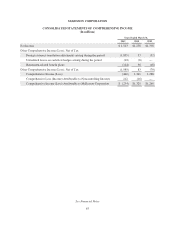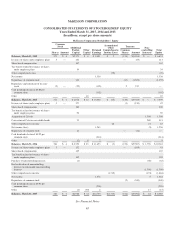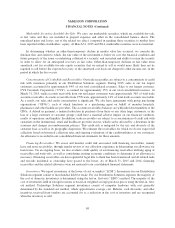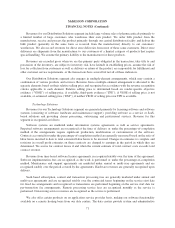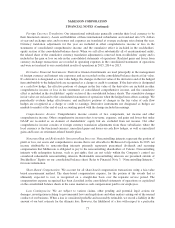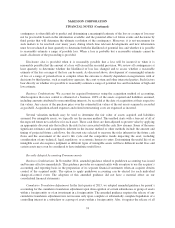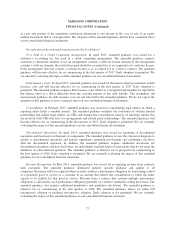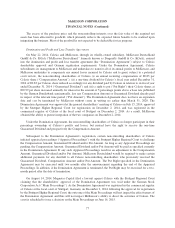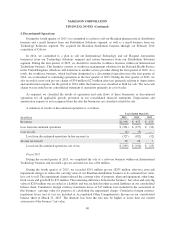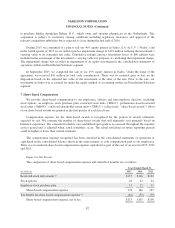McKesson 2015 Annual Report Download - page 78
Download and view the complete annual report
Please find page 78 of the 2015 McKesson annual report below. You can navigate through the pages in the report by either clicking on the pages listed below, or by using the keyword search tool below to find specific information within the annual report.McKESSON CORPORATION
FINANCIAL NOTES (Continued)
Foreign Currency Translation: Our international subsidiaries generally consider their local currency to be
their functional currency. Assets and liabilities of these international subsidiaries are translated into U.S. dollars
at year-end exchange rates and revenues and expenses are translated at average exchange rates during the year.
Currency translation adjustments for the year are included in other comprehensive income or loss in the
statements of consolidated comprehensive income, and the cumulative effect is included in the stockholders’
equity section of the consolidated balance sheets. When we sell all or substantially all of an international entity,
the related share of the cumulative currency translation adjustment is removed from stockholders’ equity and is
included in the gain or loss on sale in the consolidated statements of operations. Realized gains and losses from
currency exchange transactions are recorded in operating expenses in the consolidated statements of operations
and were not material to our consolidated results of operations in 2015, 2014 or 2013.
Derivative Financial Instruments: Derivative financial instruments are used principally in the management
of foreign currency and interest rate exposures and are recorded on the consolidated balance sheets at fair value.
If a derivative is designated as a fair value hedge, the changes in the fair value of the derivative and of the hedged
item attributable to the hedged risk are recognized as a charge or credit to earnings. If the derivative is designated
as a cash flow hedge, the effective portions of changes in the fair value of the derivative are included in other
comprehensive income or loss in the statements of consolidated comprehensive income, and the cumulative
effect is included in the stockholders’ equity section of the consolidated balance sheets. The cumulative changes
in fair value are reclassed to the consolidated statements of operations when the hedged item affects earnings. We
periodically evaluate hedge effectiveness, and ineffective portions of changes in the fair value of cash flow
hedges are recognized as a charge or credit to earnings. Derivative instruments not designated as hedges are
marked-to-market at the end of each accounting period with the change included in earnings.
Comprehensive Income: Comprehensive income consists of two components, net income and other
comprehensive income. Other comprehensive income refers to revenue, expenses, and gains and losses that under
GAAP are recorded as an element of shareholders’ equity but are excluded from net income. Our other
comprehensive income consists of foreign currency translation adjustments from those subsidiaries where the
local currency is the functional currency, unrealized gains and losses on cash flow hedges, as well as unrealized
gains and losses on retirement-related benefit plans.
Noncontrolling and Redeemable Noncontrolling Interests: Noncontrolling interests represent the portion of
profit or loss, net assets and comprehensive income that is not allocable to McKesson Corporation. In 2015, net
income attributable to noncontrolling interests primarily represents guaranteed dividends and recurring
compensation that McKesson is obligated to pay to the noncontrolling shareholders of Celesio. Noncontrolling
interests with redemption features, such as put rights, that are not solely within the Company’s control are
considered redeemable noncontrolling interests. Redeemable noncontrolling interests are presented outside of
Stockholders’ Equity on our consolidated balance sheet. Refer to Financial Note 3, “Noncontrolling Interests,”
for more information.
Share-Based Compensation: We account for all share-based compensation transactions using a fair-value
based measurement method. The share-based compensation expense, for the portion of the awards that is
ultimately expected to vest, is recognized on a straight-line basis over the requisite service period. The
compensation expense recognized has been classified in the consolidated statements of operations or capitalized
on the consolidated balance sheets in the same manner as cash compensation paid to our employees.
Loss Contingencies: We are subject to various claims, other pending and potential legal actions for
damages, investigations relating to governmental laws and regulations and other matters arising out of the normal
conduct of our business. When a loss is considered probable and reasonably estimable, we record a liability in the
amount of our best estimate for the ultimate loss. However, the likelihood of a loss with respect to a particular
73


